



Next: The head corner parser
Up: Head-corner Parsing
Previous: Linear and non-erasing grammars
A sample grammar
In this section I present a simple linear and non-erasing
constraint-based grammar for a (tiny) fragment of Dutch. As a caveat
I want to stress that the purpose of the current section is to provide
an example of possible input for the parser to be defined in the
next section, rather than to provide an account that is completely
satisfactory from a linguistic point of view.
There is only one parameterized, binary branching, and headed rule in
the grammar. The rule does not introduce any terminals. It is defined
as follows, where the first daughter represents the head:
![\pr\pred
\head{\mbox{\it sign}(\avm[\mbox{\rm M}]{ \mbox{\it syn}: \mbox{\rm Syn...
...\it cp}(\mbox{\rm M}, \langle \mbox{\rm H}, \mbox{\rm Arg}\rangle).}
\epred\epr](img294.png)
In this grammar rule, heads select arguments using a subcat list.
Argument structures are specified lexically and are percolated from
head to head. Syntactic features are shared between heads (hence I
make the simplifying assumption that head = functor, which may have to
be revised in order to treat modification). The relation `cp' defines
how the string of the mother is constructed from its daughters. In
the grammar I use revised versions of Pollard's head wrapping
operations to analyze cross serial dependency and verb
second constructions. For a linguistic background of these
constructions and analyses, cf.
[20], [49] and many others.
The value of the attribute
h-s (for `headed string') consists
of three parts, to implement the idea of Pollard's `headed strings'.
The parts
left and
right represent the strings left
and right of the head. The part
head represent the head
string. Hence, the string associated with such a term is the
concatenation of the three arguments from left to right. The
predicate
cp is defined as follows:

In the first clause, the values of
the attribute
h-s associated with the two daughters of the
rule are to be combined by the
wrap predicate. Several
versions of this predicate will be defined below. The value of
phon of the mother node is defined with respect to its
h-s value by the predicate
 .
This
predicate is defined in terms of the predicate
append/3. As an
abbreviation I write
A . B for
C such that
append(A,B,C). The definition of
.
This
predicate is defined in terms of the predicate
append/3. As an
abbreviation I write
A . B for
C such that
append(A,B,C). The definition of
 is:
is:

A few versions of the predicate
wrap are listed below, to
illustrate the idea that different string operations can be defined.
Each version of the predicate will be associated with an atomic
identifier to allow lexical entries to subcategorize for their
arguments under the condition that a specific version of this
predicate be used. The purpose of this feature is similar to the
`order' feature found in UCG
[113]. For example, a verb may select an object to its left, and
an infinite verb phrase which has to be raised. For simple (left or
right) concatenation the predicate is defined as follows:
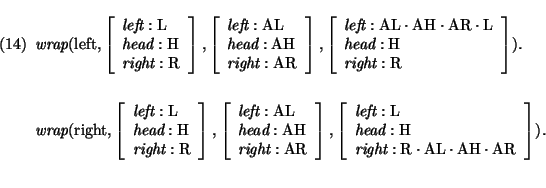
In the first case the string associated with the argument is appended
to the left of the string left of the head; in the second case this
string is appended to the right of the string right of the head.
Lexical entries for intransitive verbs such as `ontwaakt' (wakes up)
are defined as follows:
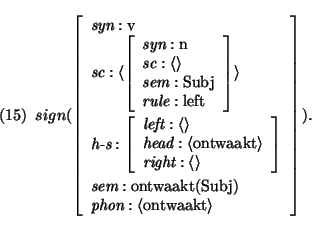
I assume that lexical entries also specify that their
phon-value is dependent on the
h-s value.
Furthermore, the values of the
left and
right
attributes of
h-s are the empty list. Henceforth, I will not
specify the values of
phon and
h-s explicitly, but
assume that each lexical entry extends

Hence, bi-transitive verbs such as `vertelt' (tells) are abbreviated
as follows:
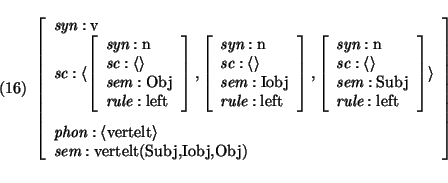
A different version of this lexical entry selects an sbar
(complementizer phrase) to the right (simplifying the argument
structure):
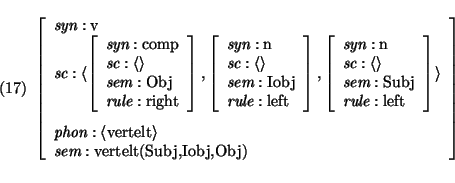
Proper nouns such as `Arie' are simply defined as:
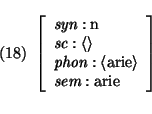
For the sake of the example I assume several other NP's to have
such a definition.
The choice of data-structure for the value of the attribute
h-s allows a simple definition of the verb raising
vr
version of the
wrap predicate that may be used for Dutch cross
serial dependencies:

Here the head and right string of the argument are appended to the
right, whereas the left string of the argument is appended to the
left. A raising verb, eg. `hoort' (hears) is defined as:
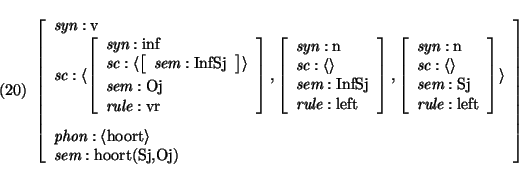
In this entry `hoort' selects -- apart from its NP-subject --
two objects, an NP and a VP (with category INF). The
INF still has an element in its subcat list; this element is
controlled by the NP (this is performed by the sharing of
InfSj). To derive the subordinate phrase

the main verb `hoort' first selects the infinitival `bob leugens
vertellen'. These two strings are combined into `bob leugens hoort
vertellen' (using the
vr version of the
wrap
predicate). After the selection of the object, resulting in `arie bob
leugens hoort vertellen', the subject is selected resulting in the
string `jan arie bob leugens hoort vertellen'. This string is selected
by the complementizer, resulting in `dat jan arie bob leugens hoort
vertellen'. The argument structure will be instantiated as
dat(hoort(jan, vertelt(arie, bob, leugens))).
Note that this analysis of verb raising constructions faces problems
because of the possibility to coordinate verb clusters. This possibility
seems to indicate that an analysis in which subcategorization lists are
manipulated (as discussed in the previous chapter) is more promising. For a
discussion of these matters, cf. [30].
In Dutch main clauses, there usually is no overt complementizer;
instead the finite verb occupies the first position (in yes-no
questions), or the second position (right after the topic; ordinary
declarative sentences).
In the following analysis an empty
complementizer selects an ordinary (finite)
vp; the resulting
string is formed by the following definition of
wrap.

The `empty' finite complementizer is defined as:
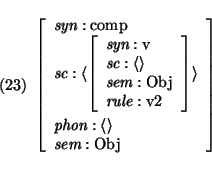
whereas an ordinary complementizer, eg. `dat' (that) is defined as:
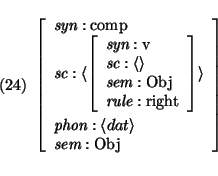
Thus, after the application of the empty complementizer, a verb
initial sentence is formed. In the case of root sentences, some
mechanism for topicalization will apply, which in some way places a
further constituent before the verb. In yes-no questions, the
derivation is finished at this point.
Note that this analysis captures the special relationship between
complementizers and (fronted) finite verbs in Dutch. The sentence

is derived as in figure 4.13 (where the head of a string is
represented in capitals).
Figure 4.13:
Deriving `Hoort Arie Jan Bob vertellen dat Claire ontwaakt'
![\begin{figure}
\begin{center}
\leavevmode
\unitlength1pt
\beginpicture
\setplot...
...ion
\put{\hbox{ARIE}} [Bl] at 336.88 378.00
\endpicture
\end{center}\end{figure}](img311.png) |
What remains to be done is to define the two grammar specific
predicates
head/2 and
yield/2. These are simply defined
as follows:
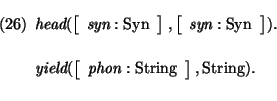




Next: The head corner parser
Up: Head-corner Parsing
Previous: Linear and non-erasing grammars
Noord G.J.M. van
1998-09-30
![\pr\pred
\head{\mbox{\it sign}(\avm[\mbox{\rm M}]{ \mbox{\it syn}: \mbox{\rm Syn...
...\it cp}(\mbox{\rm M}, \langle \mbox{\rm H}, \mbox{\rm Arg}\rangle).}
\epred\epr](img294.png)















![\begin{figure}
\begin{center}
\leavevmode
\unitlength1pt
\beginpicture
\setplot...
...ion
\put{\hbox{ARIE}} [Bl] at 336.88 378.00
\endpicture
\end{center}\end{figure}](img311.png)
